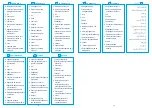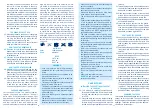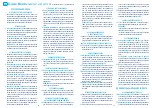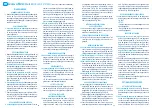
48
49
MAINTENANCE
The seat can be cleaned with soap snd lukewarm
water. Do not use any abrasive detergents. The cov-
er must be washed by hand (maximum 30°C). Do
not use a dryer. The belt buckle can be cleaned
using warm water. Do not lubricate. To ensure opti-
mum and safe use of car safety seats, they should
not be used for longer than 5 years after the date of
purchases. Ageing of the plastic,for instance, under
the influence of sunlight (UV), may quite unnotice-
ablyreduce the qualities of the product. Once the
child has grown out of the seat,we therefore advise
you to no longer use the car seat and to dispose of
it in proper way.
MATERIALS
Cover:
100% polyester
Frame:
aluminum
SIZES
L: 86 cm;
H: 60 cm;
D: 107 cm.
WARNINGS
•
This product is suitable for children from birth
to approximately 9 months (0-10kg).
•
For car seats used in conjunction with a chas-
sis, this vehicle does not replace a cot or a bed.
•
Should your child need to sleep, then it should
be placed in a suitable pram body, cot or bed.
•
To prevent your child from falling out of the
seat. Always check to make sure the carrying
handle is “clicked” into carrying positions be-
fore lifting the seat. Also make sure your child
is always strapped securely with the harness
belt.
•
The correct rooting of the seat belt along the
blue markings on the product is essential for
your child’s safety. Please see the installation
section. Never thread the belt in any other way.
•
Never use this product on a seat equipped with
a front airbag.
•
When installing with the seat belt, only use the
car seat on forward facing seat that has been
provided with an automatic or static 3-point
belt. The belt provided has been approved ac-
cording to the ECER16 standard or similar.
•
It may be used in the front seat and in the
back seat. We strongly suggest to be used in
the back seat. Always place the product rear-
ward-facing.
•
We strongly advise against using a second-
hand product, as you can never be sure of its
history.
•
In order to prevent damage to the cover, do not
remove the logos or airbag sticker.
•
The child restraint must not be used with-
out the cover. The seat cover should not be
replaced with any other than the one recom-
mended by the manufacturer, because the cov-
er constitutes an integral part of the restraint
performance.
•
It is a safety product that is only safe when
used according to the instructions given in this
manual. Do not make any alternations to the
device without the approval of the competent
authority.
•
Any luggage or other objects liable to cause
injuries in the event of a collision shall be prop-
erly secured.
•
Do not use any load bearing contact points
other than those described in the instructions
and marked in the child restraint.
FOR TECHNICAL OR COMMERCIAL REASONS,
GIORDANI RESERVES THE RIGHT, AT ANY
TIME AND ALSO ONLY IN A SPECIFIC COUNTRY,
TO MODIFY THE TECHNICAL CHARACTERISTICS
OF THE MODELS DESCRIBED IN THIS LEAFLET,
AND/OR THE SHAPE, TYPE AND NUMBER OF THE
ACCESSORIES SUPPLIED
E
G
IORDANI
M
ETROPOLITAN
SISTEMA
MODULAR
(DE 0 A 36 MESES APROX.)
SILLA DE PASEO
APERTURA DE LA SILLA DE PASEO
1.
Sacar el gancho que mantiene la silla de paseo cerra-
da, tal y como se indica en la Fig. 1a/1b/1c/1d. Se-
guidamente levantar el manillar como muestra la fle-
cha: la silla de paseo quedará completamente abierta
cuando se escuche un clic.
MONTAJE DE LAS RUEDAS
2. Montaje de la rueda delantera:
insertar los ejes de
la rueda delantera en los huecos delanteros, como se
muestra en la Fig. 2a; los ejes quedarán correctamen-
te fijados cuando se escuche un CLIC.
Montaje de la rueda trasera:
insertar los ejes de la
rueda trasera en los huecos traseros, como se mues-
tra en la Fig. 2b; los ejes quedarán correctamente
fijados cuando se escuche un CLIC.
ATENCIÓN:
antes del uso, intentar mover y girar ma-
nualmente las ruedas para asegurarse de que estén
todas correctamente fijadas en sus respectivos hue-
cos.
MONTAJE DEL ASIENTO
3.
Fijar el velcro en el sentido indicado por la flecha en la
Fig. 3a y seguidamente enganchar el botón a la parte
inferior de la colchoneta de la silla de paseo. Ahora el
asiento está completamente montado, tal y como se
muestra en la Fig. 3b.
4. Montaje del asiento:
fijar al mismo tiempo los dos
adaptadores A del asiento a la base de sujeción,
como se muestra en la Fig. 4a; las dos partes que-
darán fijadas al unísono de manera estable cuando
se oiga un CLIC.
5. Fijación del soporte del reposapiés:
apretar con
el dedo en ambos lados de los enganches C, como
muestra la Fig. 5a, y empujar el soporte D en el conec-
tor de plástico. El soporte quedará fijado de manera
estable cuando se oiga un CLIC (ver Fig. 5b).
6. Fijación de la barra frontal:
coger la barra frontal y
apretar al mismo tiempo los botones blancos situados
en ambos lados de la misma, como se muestra en la
Fig. 6a. Seguidamente proceder con la fijación de la
barra frontal en los dos lados de la silla de paseo, hasta
que se oiga un CLIC.
7.
Tal y como muestra la Fig. 7a/7b/7c, abrir la crema-
llera de la capota siguiendo el sentido de la flecha,
y empujarla hacia delante: la silla de paseo quedará
estable y correctamente abierta.
MONTAJE Y DESMONTAJE DE LA CAPOTA
8. Para quitar la capota:
coger el elemento de plástico C
y sacarlo del canal D que contiene el elemento de plás-
tico, como indica la flecha (ver Fig. 8d/8e); ver Fig. 8a,
sacar el tejido de la capota como muestra la flecha (ver
Fig. 8f), sacar la barra de hierro E del canal que con-
tiene el elemento de plástico, como se muestra con la
flecha; ahora la capota puede quitarse completamente.
9. Montar la capota:
ver Fig. 8a/8b. Insertar el extremo
posterior A del tejido de la capota e introducirlo en el
canal de la silla B, con una mano presionar y empujar el
tejido en el canal y al mismo tiempo, con la otra mano,
tirar de la parte delantera del tejido, tal y como muestra
la flecha: la capota está ahora montada. Ver Fig. 9a, in-
sertar la guía de la capota en la correspondiente base,
como muestra la flecha, asegurándose de que el punto
G de la base esté fijado en el orificio de la guía. Ver la
Fig. 9b/9c/9d. Insertar el extremo delantero B del tejido
de la capota en la parte frontal del tubo de la capota
y fijar el tubo en el canal de la guía, como muestra la
flecha; ahora la capota está completamente montada
(ver Fig. 8).
FUNCIONAMIENTO DEL MANILLAR
10. Regulación en altura del manillar:
ver Fig. 10, apretar
el pulsador con una sola mano y levantar el manillar
hacia arriba o hacia abajo. Se aconseja regular la al-
tura del manillar.
ASIENTO RECLINABLE
11. Desbloqueo rápido del asiento:
vver Fig. 11a/
11b/11c. Presionar al mismo tiempo el retén de se-
guridad en ambos lados de la silla y levantarlo. La
silla puede retirarse rápidamente o ser colocada en
sentido contrario.
ATENCIÓN:
mantener a los niños alejados de la si-
lla de paseo mientras se esté desenganchando el
asiento.
REGULACIÓN DEL ASIENTO
12.
Presionar el dispositivo de regulación sobre el res-
paldo o bien girar la manivela, el ángulo del respaldo
se puede regular. La silla puede regularse en 4 posi-
ciones.
TRANSFORMACIÓN DE ASIENTO EN SUAVE CAPAZO
13.
Lo primero que hay que hacer es darle la vuelta al
asiento, como se muestra en la Fig. 13a. Presionar
el pulsador 1 para regular el asiento en posición ho-
Summary of Contents for metropolitan
Page 6: ...11 7b 6a 7a 8 7c 4a 3a 5a 4b 3b 5b 10 A B C D 8a 8b 8C A B...
Page 13: ...24 25 39a 38a 38b 35b 36b 36a 35a 37a 34c 40a 1 2 3 4 1 2 B A 39b 39c 165 40b 1 2...
Page 15: ...29 46a 46b 47a 47b 48a 28 42g 43a 43b 44 45a 45b 2 1 B A 48b 48c...
Page 47: ...7 NOTE NOTES NOTAS NOTA OPMERKINGEN NOTES...
Page 48: ...6 5...
Page 49: ...4 3...
Page 50: ...SA 1 2...
















































